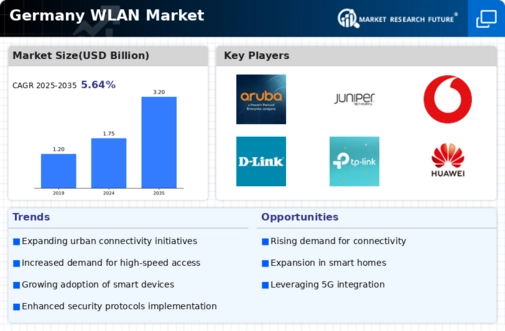Emergence of 5G Technology
The rollout of 5G technology in Germany is poised to revolutionize the wlan market. With its promise of ultra-fast data speeds and low latency, 5G is expected to complement existing wlan solutions, enhancing overall connectivity. As telecommunications companies expand their 5G networks, businesses and consumers are likely to seek wlan solutions that can leverage this advanced technology. The potential for 5G to support a higher density of connected devices may drive demand for wlan infrastructure capable of handling increased traffic. Furthermore, the integration of 5G with IoT applications could create new opportunities for the wlan market, as industries explore innovative use cases that require high-speed wireless connectivity. This convergence of technologies may lead to a transformative impact on how businesses and consumers interact with digital services.
Expansion of Remote Work Culture
The shift towards remote work in Germany has significantly influenced the wlan market. As organizations adapt to flexible work arrangements, the need for reliable wireless connectivity has surged. Data indicates that approximately 60% of employees in Germany now work remotely at least part-time, creating a pressing requirement for high-performance wlan solutions. This trend compels companies to invest in advanced wireless technologies to ensure employees can maintain productivity from various locations. The wlan market is likely to benefit from this transformation, as businesses prioritize secure and efficient wireless networks to support remote collaboration tools and cloud-based applications. Furthermore, the demand for enhanced security features in wlan solutions is expected to rise, as organizations seek to protect sensitive data transmitted over wireless networks.
Increased Focus on Cybersecurity
As cyber threats become more sophisticated, the wlan market in Germany is witnessing a heightened emphasis on cybersecurity measures. Organizations are increasingly aware of the vulnerabilities associated with wireless networks, prompting them to invest in advanced security protocols. Reports suggest that nearly 40% of businesses in Germany have experienced a cyber incident related to their wireless infrastructure. This alarming statistic drives the demand for wlan solutions that incorporate robust security features, such as encryption and intrusion detection systems. Consequently, manufacturers are likely to innovate and enhance their offerings to meet these security needs, thereby fostering growth in the wlan market. The integration of artificial intelligence and machine learning in security solutions may further transform the landscape, providing proactive measures against potential threats.
Rising Adoption of Smart Devices
The increasing penetration of smart devices in Germany is a pivotal driver for the wlan market. As households and businesses integrate smart technologies, the demand for robust wireless networks escalates. Reports indicate that over 70% of households in Germany own at least one smart device, necessitating reliable and high-speed wireless connectivity. This trend is likely to propel investments in wlan infrastructure, as users seek seamless connectivity for devices such as smart speakers, security systems, and home automation tools. Consequently, the wlan market is expected to experience substantial growth, with projections suggesting a compound annual growth rate (CAGR) of around 8% over the next five years. The proliferation of Internet of Things (IoT) applications further amplifies this demand, as businesses and consumers alike require efficient wireless solutions to support their interconnected environments.
Growth of E-commerce and Digital Services
The rapid expansion of e-commerce and digital services in Germany is a significant catalyst for the wlan market. With online shopping becoming increasingly prevalent, businesses require reliable wireless networks to facilitate seamless transactions and customer interactions. Data indicates that e-commerce sales in Germany reached approximately €100 billion in 2025, underscoring the critical role of effective wlan solutions in supporting this growth. As retailers and service providers enhance their online platforms, the demand for high-speed wireless connectivity is expected to rise. This trend may lead to increased investments in wlan infrastructure, as companies seek to optimize their digital presence and improve customer experiences. Furthermore, the integration of advanced technologies, such as augmented reality and virtual reality in e-commerce, could further drive the need for enhanced wlan capabilities.




















Leave a Comment